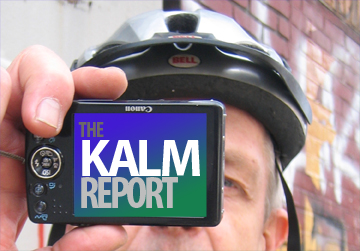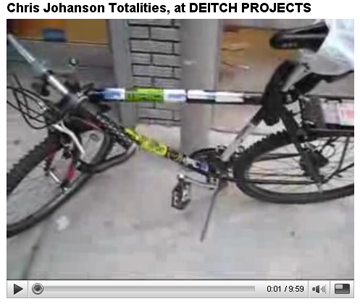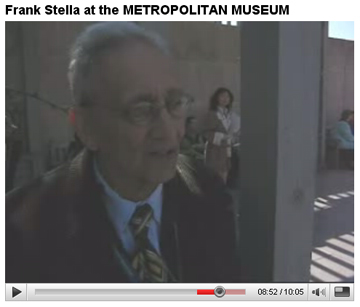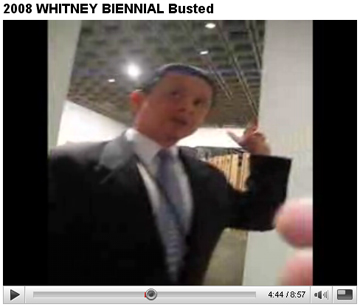
While I promised a view of DUMBO’s Art Under the Bridge festival today, I will have to leave that for tomorrow. But I did want to post this interview with one of the most colorful characters in New York’s online arts community, the vlogger known as James Kalm.
Loren Munk is an artist, a writer, a husband, and a father. He paints thickly covered canvases that play with text, maps, diagrams and illustration as a form of critique and illumination. His two-dimensional work looks heavy and resembles the impasto of Californian artist Jess (Collins).
Then there’s James Kalm, his alterego. James makes The Kalm Report, a serialized online video program that has toured the studios of many New York artists (Chris Martin, Phong Bui, Cris Dam, William Powhida), run into people at exhibitions (including Jonas Mekas), and offered online viewers free tours of shows and events they probably wouldn’t or couldn’t see otherwise (like this panel discussion on The Legacy of Abstract Painting, 1960s-1970s). All in all, his perspective is both entertaining and insightful.
Kalm is an eye into the city’s constantly evolving arts scene. To date, The Kalm Report has posted 231 videos since November 2006. A few have been viewed over 7,500 times (which is remarkable for videos that are usually 10 minutes long) and many have dozens of comments–the video on Cy Twombly’s Blooming exhibit at Chelsea’s Gagosian Gallery last November clocked in 128 comments.
James agreed to talk to me about his online video performances that inevitably begins with a view of his bike and ends with his Edward R. Murrow-esque “goodnight Kate.”

THE INTERVIEW
Hrag Vartanian: First off, how do you want to be identified?
James Kalm: You can identify me as James Kalm, which is a pseudonym I’ve been using for my writing and video work for over ten years now. Because of my instinctive distrust of art criticism (having been an artist for over thirty-five years) I wanted to make a distinction between my work as a painter named Loren Munk and the critic/writer.
I tend to think of [The Kalm Report] more as art-recon, an urban commando collecting data that will help document the community and actions making up the New York art scene circa 2008.
Hopefully I’m helping to blur these lines. Much of my recent painting deals with the concepts of representing the principles of art criticism, aesthetics, history, and influence graphically with paint. Although I hate “art theories” I’ve got one I’m working on called The Physics of Aesthetics. Basically a more “scientific” view of the elements that make up the idea of “taste.”
HV: How did the The Kalm Report come into being?
JK: About three years ago I started watching video clips on YouTube. I read some articles about YouTube stars who’d made reputations, gotten gobs of attention, been discovered by Hollywood and gotten hundreds of thousands of hits. I had no expertise in video at all, no idea how to edit, shoot it or post it. In fact, I generally avoided video when I came in contact with it in gallery situations. As stated above, I’d been documenting the scene photographically for years (I have tens of thousands of photos) but had recently gone digital. One day while shooting pictures with my little Canon Elf, I flipped the mode switch too far and started shooting video. I got home, downloaded the day’s pics, and watched the video snippets. They were funny and interesting. I laughed, but I had no idea what to do with them.
About the same time Irving Sandler (the Dean of American Art History and Criticism), published an open letter to art critics in the Brooklyn Rail titled “The Crisis in Criticism.” One of his complaints was that no one was paying attention to art critics anymore. They were academic and boring, money and the market had taken over, and hence, art was suffering from over-priced mediocrity.
Being a practical joker and trickster, always looking for ways to extend the reach of my high-jinx, I envisioned using YouTube as a means to reach a new audience that was unserved by the likes of ARTFORUM, Art in America and the other tony New York art publications.
I went to the Fountain Art Fair, turned on the camera, and started talking and shooting. Fortunately I have some very computer savvy kids and they helped me learn how to upload and edit the work. The rest has been an embarrassing case of learning how to make videos in public, and mostly I’ve enjoyed every second of it.
HV: Any way to gauge how many viewers you have? And what have been some of the craziest reactions to your video logs?
JK: My highest viewed is Jason Rhoades’ Black Pussy (which shows the importance of a good title) at nearly 18,000 and some of the lesser have gotten only two hundred fifty [hits]. Right now a good “Report” should generate between four and eight hundred in the first week. Sometimes they pop and hit a couple thousand right away, then they usually slow down.
Crazy reactions? One of the best stories was the bashful artist whose opening I dropped in on. I coaxed her into an interview and tour, but she was irritated and wouldn’t talk to me for months. Finally, I get a gushing e-mail and a belated thank you. Seems she was being audited by the IRS. Because she wasn’t making enough profit from the art. They were going to disallow her deductions (she’s a sculptor so there’s a lot of cash involved in fabrication). During the audit her accountant goes online and pops up her program at The Kalm Report. After viewing it, the IRS guy said that she obviously was an artist, so the deductions were valid.
HV: Who was your most riveting interview and why? In other words, does creating The Kalm Report give you another perspective on the artists or does it make you interested in capturing artists whose work looks better on video?
JK: Jeff Koons and Frank Stella, both on the roof at the Met were great chats (the Met has been very accommodating to The Kalm Report). Being blown off by Neo Rauch also at the Met was fun.
My announced goal with The Kalm Report has always been to show people not only the art in the New York City scene, but to dig deeper and try and show the real art world, the behind the scenes stuff, the challenges a regular guy on a bike runs into. In some cases it works on video, in others, I’m hopping the narration might help get the point across.

HV: You also write criticism. Do you consider your videos works of criticism?
JK: Some of the writing could be categorized as criticism, some of it as cultural reporting or journalism, and some tending towards historic documentation.
In an attempt to inoculate myself from charges of journalistic exploitation, in a brief monologue at the beginning of “2008 Whitney Biennial Busted” (the video where I was kicked out of the Museum), I stated that I see The Kalm Reports as a mix of all the above, but also as autonomous works of art in themselves Some very prescient reporters like yourself, and Steven Kaplan, have realized that the videos are a form of performance art, a free form “flow of consciousness” monologue on art and the art world. I’m also trying to maintain an irreverent, almost Dadaistic, sense of humor. To quote Ad Reinhardt, “art is too serious to be taken seriously.”
Because I’ve structured the videos to be direct and taped live (usually no voice over narrative recorded later in the studio), I don’t intentionally delve into straight criticism. I don’t have time to make the in-depth analysis and interpretation that serious criticism requires. Some work I’m familiar with and might have reviewed before so I can judge a bit better, but I’m hoping to give the viewer a chance to make their own decisions. I think that’s one of the great things about video that you can’t get from print reviews, even with photos.

HV: Is there any work of art that really tested the limits of The Kalm Report? In other words, did you ever come across something that you said “I can’t cover this, it won’t show up on video or won’t make sense to the viewer”?
JK: Because of my production values, I’m willing to try to record just about anything. In some ways, it’s part of the creative challenge to figure out how to photograph things. With subtlety or ephemerality I can usually catch something and then try to explain. Antony Gormely’s Blind Light at Sean Kelly was a giant glass box full of fog. I walked in, and for the next three minutes you see nothing on the screen but grey. I had to keep talking to describe the work and what I was experiencing. Later, to put it all into context, I recorded the outside of the box and the other pieces of sculpture in the show. Some things in dark rooms just don’t show up. I did a black light show, Jocelyn Shipley’s Secret Life of Sculpture at Canada, which I didn’t know if it would come out but it looked pretty good. What I do try to avoid is boring art, although I’ve recorded more than my share of that stuff too.
HV: What’s the future of The Kalm Report? Any aspirations for a more professionally-produced program or series?
JK: “Professionally-produced” would imply that there is some money coming in, some wages being paid, and as much as I encourage and welcome people sending me cash, in the almost two years and the over 225 Kalm Reports produced, I have yet to extract one penny from this project.
For me, one of the beauties of The Kalm Report is that aside from time and energy there is very little cost involved. A goal of mine from the beginning was to show viewers that there are ways to circumvent the established elite media outlets, to go directly to the people and open their eyes. If someone is creative and innovative they don’t need a lot. All they need is an idea, a bike, and a two dollar camera. Maybe they can change the way the world sees art…stay tuned…thanks Kate
Tomorrow: If all goes well, then finally my take on the 2008 DUMBO’s Art Under the Bridge festival




Pingback: The Digest. 09.29.09. at C-MONSTER.net
Pingback: Week Two on Art21
Pingback: The Unedited Email Interview with James Kalm